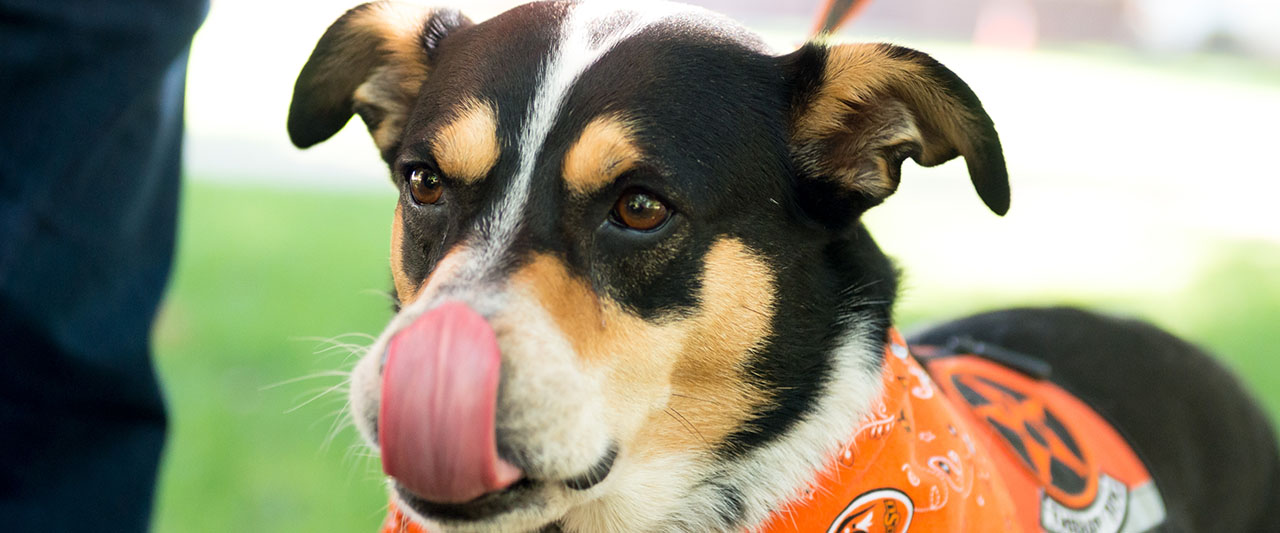One of Oklahoma State University’s primary traits is the cultivation of a friendly campus that helps students feel as if they are part of a family. For many, family includes pets. Through a cross-campus, collaborative effort, Pete’s Pet Posse (P3, for short) was established in Fall 2013 to introduce pet therapy dogs in hopes of making the OSU campus feel even more like home.
In four short years, eight dogs associated with College of Arts and Sciences’ faculty and staff have earned their “barkalaureates,” and more are on the way. The popularity of the program has grown by traditional word-of-mouth as well as hand-to-fur.
“We have two dogs, Sandy D. and Chunk, in Life Sciences East, where I work,” Assistant Dean for Outreach Bobbi Kay Lewis says. “Their owners told me about the program and what great experiences they’ve had in the program, which inspired me to get on board.”
P3 owners and their dogs must first submit an application in August and September, then, upon acceptance into the program, complete extensive training which begins in January. Graduation from the program includes obtaining the Canine Good Citizen (CGC) certification and national registration with the Alliance of Therapy Dogs. They collaborate with their department to develop a work schedule and also participate in P3 special events throughout the year. It can make for a significant time commitment, but one that reaps bountiful rewards.
Bret Danilowicz, Dean of the College of Arts and Sciences, recalls one student who burst into tears upon seeing his dog, Sandy D. She laid down with Sandy, hugged her, and cried for several minutes. Then she stood up, smiled, and said, “I really needed that,” before walking away.
“We never exchanged names or greetings – but in that moment, we didn’t need to,” Danilowicz says. “She just needed Sandy.”
Most interactions involve smiles and laughter. As the program enters its fifth year at OSU, students have come to look for dogs wearing the orange P3 vests. Even prospective students who visit the campus have taken notice.
“I remember one Freshman during a visit who told me she decided to come to OSU because of P3,” Leslie Baldwin, undergraduate advisor for the Department of Communications Sciences and Disorders (CDIS), says.
Pet therapy is quickly growing in popularity, and not just in academia. Hospitals, retirement homes, nursing homes, schools, hospices, people with learning difficulties, and stressful situations such as disaster areas have all taken advantage of this unique approach. The OSU Pet Therapy Program was designed to contribute to the America’s Healthiest Campus initiative.
“Mental health often gets overlooked, and petting a dog one day may be all the student needs to change their attitude,” Baldwin says. “I am often reminded that it’s the little things in our daily lives that add up to the big things, and I think P3 is just that.”
Baldwin also shares her dog, Roscoe, with the CDIS Animal Assisted Intervention program. This allows Roscoe to interact with children with autism and clients that stutter. They have found a “marked difference” when dogs like Roscoe are able to participate in the sessions.
Holley Hansen and Stephen Nemeth (both in political science) have noticed how their dog Cooper has power to bring people together.
“During visits, you will often see a circle of students who have never met each other, all from different backgrounds, social groups, and majors, talking about themselves or their dogs back home,” Hansen says. “These may be temporary or little connections, but they can help students feel a lot more at home.”
While the primary benefactors of the P3 dogs are stressed-out students, faculty, and staff, the owners enjoy the perk of taking their dogs to work. Lewis says her favorite days are when she brings her lab mix Logan to Life Sciences East.
“You not only get to build a better relationship with your dog and bring him/her to comfort you and others on campus, you get an opportunity to connect with so many different people and students,” she says. “It is incredible to see the stress just melt off people while they are petting your dog.”
Baldwin concurs. She felt guilty leaving Roscoe at home every day and the more she learned about the program, the more she realized how much it helped the dog.
“It is a symbiotic relationship,” she explains. “Roscoe is always excited when we put the vest on and we go to campus.”
Roscoe is not the only P3 dog to get excited. Some may even get too excited. Hansen and Nemeth discovered Cooper could strain his tail from wagging too much. In fact, he did so twice.
“He really loves his job,” Hansen says.
The owners love the job, too. While the entire P3 group feels like a family, in some cases it is literally true, for many campus couples share P3 duties (and rewards). Danilowicz and his wife Kay (Communications Sciences and Disorders) share Sandy D., for instance. Hansen and Nemeth handle Cooper, Tyrell Conway, Microbiolgy and Molecular Genetics, and his wife Sharri bring Chunk, Darwin and Huxley belong to Keith Garbutt, Dean of the Honors College and Professor of Plant Biology, and his wife Christine Garbutt, and Toby is shared by Michael, Geology, and Susan, OSU Fire Protection Publications, Grammer. Rebecca Sheehan, Geography, adds Goose as a P3 pet in the College of Arts and Sciences.
Danilowicz could not be happier so many dogs have joined Sandy D. in the program.
“Since this is purely a volunteer program, it is wonderful to see so many of our faculty and staff from the college supporting our campus this way.”

